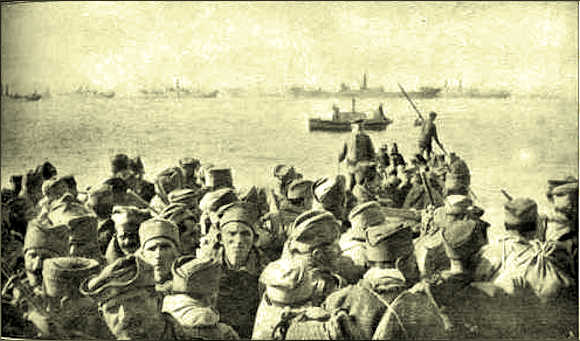 |
| Exhausted Serbian Troops Departing Albania |
The Macedonian (or Balkan) Front heated up dramatically in late 1915. Both the Central Powers and Allies chose to commit major resources to the sector. At stake was the fate of Serbia. French and British forces began disembarking at Salonika without incident on 5 October 1915; further divisions were en route. German and Austrian troops unleashed a major offensive against the Serbs the following day, and Bulgaria declared war on Serbia a week later. Serbia was now exposed to Bulgarian attack from the east. In late October, the overall commander at Salonika, the politically attuned French General Maurice Sarrail, pushed forces north across the Serbian border to support the Serbian Army, which had finally crumbled and retreated after a brave stand at Kosovo in central Serbia.
With a harsh winter closing in and still largely equipped for a Gallipoli summer, there was little the Anglo-French troops could do to assist the Serbs. The 10th (Irish) Division fought a desperate defensive action against the Bulgars in the snow at Kosturino in December 1915 before the Anglo-French force fell back on Salonika. More than 6000 casualties were suffered during the failed advance into southern Serbia. The remains of the Serbian Army, shattered in battle and suffering from an epidemic of typhus, were forced into a desperate retreat across the mountains into Albania. By the time they arrived at Tirana for evacuation to Corfu by Anglo-French ships, the sick and starving Serbian forces had ceased to exist as a fighting force.
 |
| Things Were Rough at First on Corfu |
However, by the spring of 1916, the shattered Serbian Army was being rebuilt and rearmed by the French on the island of Corfu in the Ionian Sea. The epic story of the defeated Serbian Army of 1915 somehow escaping, rebuilding itself with the help of its Allies, and becoming an effective and valuable fighting force is a remarkable one.
By the end of October 1915 the retreating Serbs had been gradually withdrawing to the south, desperately hoping for the Allies’ promised aid. Unfortunately, the French and British arrival in Salonika was far too slow to create a strong army of 150,000 men on time, and match Bulgarian advancement in South Serbia. However, the Allies for many reasons did not engage in larger-scale action. Meanwhile, the Second Bulgarian Army managed to cut off the Serbian escape route to Salonika by taking Skopje on 22 October and then pushed northwestward to Kosovo. Finally, the Serbian Army, followed by a large number of refugees, withdrew to the Kosovo Valley, thus escaping on several occasions the enemy’s attempts to cut it off and force surrender.
On 25 November, the Serbian High Command issued the order to retreat through Montenegro and Albania, to join the Allies and continue the war out of the country. The Serbian High Command emphasized that its army was not in a favorable condition for a counteroffensive, but that capitulation was viewed as a worse choice. The epic retreat through high, snowy mountains, in poor clothes, with no food and medical supplies, sometimes through the hostile Albanian villages, claimed thousands of soldiers’ lives and left many wounded. The sufferings were similar for the civilians and prisoners of war who moved alongside their once victors.
 |
| Traditional Dancing to Raise Morale |
France led the Allies in organizing a rescue mission and helped save the Serbian Army on the Albanian littoral by evacuating it to the island of Corfu. The first phase was evacuation from Albania. Some eighty-seven liners and hospital ships were engaged, along with seventy war ships. The second phase was recovery and reorganization. By the end of February 1916, 169,828 soldiers and civilians were transferred to Corfu, Bizerte, Italy, and France.The Allies had not had enough time to make provisions for adequate care of such a great number of people. There was a lack of food, clothes, tents and heating at Corfu.. Starved and worn down by the hardship of the march, at least 30,000 of the Serbs died soon after reaching the island, mostly victims of flu brought on by cold, rain and exposure to the elements. Some were children. After several months of recovery, some 125,000 Serbian troops were shipped to Khalkidhiki near Salonika
As part of the overall Allied offensive strategy in 1916, it was decided that the troops in Salonika would advance from the city against these Bulgarian positions. The first troops moved north in April, with the French taking up positions west of the Vardar River. Supported by Russian and Italian troops and later, the refitted Serbian Army, they captured the strategic town of Monastir on 19 November.
 |
| Ready for Action: Rested and Refitted, Serbian Troops on Corfu Ready for Deployment to Salonika |
In September 1918 the rebuilt Serbian Army would make a decisive breakthrough of the Bulgarian lines in the west, allowing French cavalry to advance past them across undefended mountain passes.strategically outflanking the Bulgarian Army. On 21 September, the British troops at Doiran realised the now outflanked Bulgarians facing them had retreated and were streaming across the mountains towards their own country, harassed by aircraft. With a collapse in civil order at home, the Bulgarian Army crumbled and on 30 September an armistice came into effect.
Sources: Today in World War I, Balkan Insight; New Zealand History, Imperial War Museum; "Serbia" 1914-1918 Online

No comments:
Post a Comment